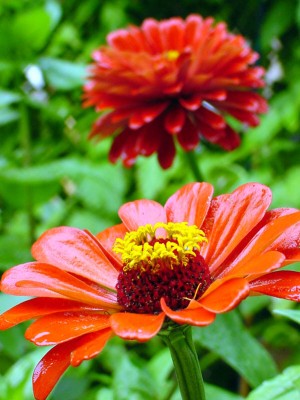
|
|
Zinnia
elegans
|
Zinnia (Zinnia spp.)
Zinnias
are cheerful, fun-looking flowers, almost like a lollipop on a stick.
The straight stems are topped by a pom-pom of bright candy colours.
Zinnias are native to Mexico where the Spaniards called it mal de ojos,
because the flowers were small and considered ugly to the eye. First
cultivated in Austria in 1613. Zinnia elegans, is the most commonly
grown kind along with its many different varieties. There are both
single and double flowered kinds. Zinnia form bushy, erect, self-branching
plants, growing 1 to 4 feet in height. Zinnia flowers are virtually in
every colour except blue, from May to October. In the language of
flowers, Zinnia appropriately stands for "thoughts of absent
friends".
For decades, zinnias have been the flowering annual of choice for spreading
glorious colors throughout the garden as well as for cutting to bring
indoors. But it wasn't always so. When the Spanish first saw zinnia
species in Mexico, they thought the flower was so unattractive they
named it mal de ojos, or "sickness of the eye!"
The Marchioness of Bute was sent the seeds of the Zinnia from Mexico by
Professor Casimir Gomez de Ortego. The Marchioness was wife to the
British Ambassador to Madrid and daughter-in-law to John Stuart Bute who
was director of the Royal Botanical Gardens at Kew.
Even after
seeds of zinnias were sent back to Europe in the 18th century, the
plants were not much to look at.
The zinnia
is among the many flowers named for botanists. It commemorates Johann
Gottfried Zinn (1727-1759) the German professor of botany and
medical professor at Gottingen University who wrote a description of the
flora around Gottingen. Zinn, wrote the first description of the flower.
‘he genus
Zinnia had to wait for the late 19th century to become more successful
as a garden annual. But the start of the zinnia's real popularity began
around 1920 when Bodger Seeds Ltd. introduced the dahlia-flowered 'Giant
Dahlia'.
One of the
reasons for the popularity of the zinnia is the diversity of its forms.
Like dahlias and chrysanthemums, zinnias have a variety of flower forms
and may be single, semidouble, or double. Zinnias also have an amazing
number of colors; in fact, flowers come in almost every shade except
blue. Most are solid, but some, in particular Z. haageana, are bicolored
with a contrasting color at the tip of each petal.
Source:
http://www.flowers.org.uk/flowers/facts/s-z/zinnia.htm
http://www.bostongardens.com/bostongardens/
detail.cfm?id=2101&catid=1&webid=1
